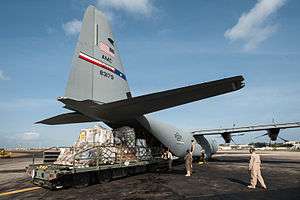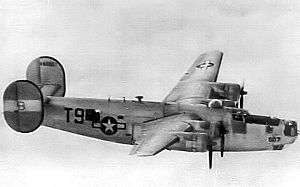787th Air Expeditionary Squadron
| 787th Air Expeditionary Squadron | |
|---|---|
 Airmen and equipment deploy as the 787th Air Expeditionary Squadron for Operation United Assistance | |
| Active | 1943-1946; 1965; 2006; 2014–2015 |
| Country |
|
| Branch |
|
| Role | Expeditionary operations |
| Part of | United States Air Forces Europe |
| Engagements | European Theater of Operations |
| Insignia | |
| Patch with unofficial 787th Bombardment Squadron emblem[1][2] |
 |
The 787th Air Expeditionary Squadron is a provisional United States Air Force unit, assigned to United States Air Forces Europe. The squadron has been activated twice for contingency operations in Africa.
The squadron was first activated during World War II as part of the 466th Bombardment Group. After serving in the European Theater of Operations it was inactivated at Davis-Monthan Field, Arizona on 17 October 1945.
In 1965, the squadron was briefly active under the 33d Tactical Fighter Wing as a McDonnell F-4 Phantom II squadron, but its personnel and equipment were transferred to another unit within four months of its activation.
History
World War II

Established in mid-1943 as a B-17 Flying Fortress heavy bomb group; trained under Second Air Force in Idaho. Completed training in early 1944; deploying to European Theater of Operations (ETO) assigned to VIII Bomber Command in England.
Engaged in long-range strategic bombardment operations over Occupied Europe and Nazi Germany, March 1944-May 1945 attacking enemy military and industrial targets as part of the United States' air offensive against Nazi Germany. Most personnel demobilized in Europe after the German capitulation in May 1945; a small cadre returned to the United States, being programmed for conversion to being a B-29 Superfortress very heavy bomb squadron and deployment to the Central Pacific to engage in strategic bombardment over Japan.
Training ended after Japanese capitulation in August 1945, unit inactivated in October; its training aircraft being assigned to other squadrons or sent to storage.
Fighter operations
As the United States Air Force expanded its McDonnell F-4 Phantom II fleet in April 1965, it activated the 33d Tactical Fighter Wing at Eglin Air Force Base Florida. Although it was planned that the squadrons of the 33d Wing would be Convair F-102 Delta Dagger squadrons that were inactivating in the Pacific, these squadrons were still winding down their operations, so the 33d was initially formed with the 786th, 787th, 788th and 789th Tactical Fighter Squadrons. The 33d embarked on a program of tactical training with the Phantom. In June 1965, the squadron was inactivated and its planes and personnel were transferred to the 16th Tactical Fighter Squadron, which moved on paper to Eglin from Misawa Air Base, Japan.[3]
Expeditionary unit
In April 2006, the squadron was converted to provisional status as the 787th Air Expeditionary Squadron and assigned to United States Air Forces Europe to activate or inactivate as needed. It deployed to Karadje, Niger in July to support Operation Eagle Vision, downloading satellite imagery for mapmaking.[4]
The squadron was activated at Dakar, Senegal, where it established a transportation hub for Operation Unified Assistance, the US military name for humanitarian operations to limit the spread of Ebola in West Africa. It relieved members of the Kentucky Air National Guard's 123d Contingency Support Group. It continued airlift missions with Lockheed C-130 Hercules aircraft for the next four months.[5][6]
Lineage
- Constituted as the 787th Bombardment Squadron (Heavy) on 19 May 1943
- Activated on 1 August 1943
- Redesignated 787th Bombardment Squadron, Heavy c. 10 August 1944
- Redesignated 787th Bombardment Squadron, Very Heavy on 5 August 1945
- Inactivated on 17 October 1945[7]
- Redesignated 787th Tactical Fighter Squadron on 9 February 1965 and activated (not organized)
- Converted to provisional status and redesignated 787th Air Expeditionary Squadron on 24 April 2006
Assignments
- 466th Bombardment Group, 1 August 1943 – 17 October 1945[7]
- Tactical Air Command, 9 February 1965 (not organized)
- 33d Tactical Fighter Wing, 1 April–20 June 1965[3]
- United States Air Forces Europe to activate or inactivate as needed after 24 April 2006
- Attached to 86th Airlift Wing, July 2006
- Attached to 435th Air Ground Operations Wing, c. 18 November 2014 – c. 13 February 2015
Stations
- Alamogordo Army Air Field, New Mexico, 1 August 1943
- Kearns Army Air Base, Utah 31 August 1943
- Alamogordo Army Air Field, New Mexico, 30 November 1943 - 10 February 1944
- RAF Attlebridge (AAF-120),[9] England 9 March 1944 - c. 6 July 1945
- Sioux Falls Army Air Field, South Dakota, 15 July 1945
- Pueblo Army Air Base, Colorado, 25 July 1945
- Davis-Monthan Field, Arizona, 15 August-17 October 1945[7]
- Eglin Air Force Base, Florida, 1 April–20 June 1965[8]
- Karadje, Niger, July 2006[4]
- Léopold Sédar Senghor International Airport, Sengal, c. 18 November 2014 – c. 13 February 2015[5][6]
Aircraft
- Consolidated B-24 Liberator, 1943–1945
- Boeing B-29 Superfortress, 1945[7]
- McDonnell F-4 Phantom, 1965[8]
- Lockheed C-130J Hercules[6]
References
- Notes
- ↑ Aircraft is Consolidated B-24J-180-CO Liberator serial 44-40807
- Notes
- ↑ Watkins, pp. 105-106
- ↑ See Maurer, Combat Squadrons, p. 756 (no official emblem)
- 1 2 Bailey, Carl E. (November 28, 2007). "Factsheet 33 Fighter Wing (ACC)". Air Force Historical Research Agency. Retrieved February 13, 2017.
- 1 2 3 Dorrance, Capt Erin (August 26, 2011). "Ramstein Airmen assist villagers in Niger". European Command Public Affairs. Retrieved February 15, 2017.
- 1 2 3 Greer, Maj Dale (November 18, 2014). "Kentucky Air Guard completes Ebola-response mission in Senegal". Joint Task Force Senegal Public Affairs. Retrieved February 15, 2017.
- 1 2 3 4 Taunton, Capt Sybil (February 13, 2015). "AF Ebola support winds down". European Command Public Affairs. Retrieved February 15, 2017.
- 1 2 3 4 Maurer, Combat Squadrons, pp. 755-756
- 1 2 3 4 See Bailey, Factsheet 33 Fighter Wing
- ↑ Station number in Anderson.
Bibliography
![]()
- Anderson, Capt. Barry (1985). Army Air Forces Stations: A Guide to the Stations Where U.S. Army Air Forces Personnel Served in the United Kingdom During World War II (PDF). Maxwell AFB, AL: Research Division, USAF Historical Research Center. Archived from the original (PDF) on 23 January 2016. Retrieved 7 July 2012.
- Maurer, Maurer, ed. (1983) [1961]. Air Force Combat Units of World War II (PDF) (reprint ed.). Washington, DC: Office of Air Force History. ISBN 0-912799-02-1. LCCN 61060979. Retrieved December 17, 2016.
- Maurer, Maurer, ed. (1982) [1969]. Combat Squadrons of the Air Force, World War II (PDF) (reprint ed.). Washington, DC: Office of Air Force History. ISBN 0-405-12194-6. LCCN 70605402. OCLC 72556. Retrieved December 17, 2016.
- Ravenstein, Charles A. (1984). Air Force Combat Wings, Lineage & Honors Histories 1947-1977 (PDF). Washington, DC: Office of Air Force History. ISBN 0-912799-12-9. Retrieved December 17, 2016.
- Watkins, Robert (2008). Battle Colors: Insignia and Markings of the Eighth Air Force In World War II. Vol I (VIII) Bomber Command. Atglen, PA: Shiffer Publishing Ltd. ISBN 0-7643-1987-6.